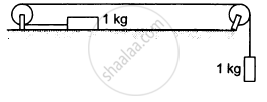Advertisements
Advertisements
Question
A ball is thrown upward and reaches a maximum height of 19.6 m. Find its initial speed?
Solution
Maximum Height attained by ball = 19.6 m
Let initial speed of ball = u ms-1.
Acceleration applied on ball due to gravity = -9.8 ms-2.
Final speed of ball at maximum height = 0 ms-1.
We know that from second equation of motion
V2 - u2 = 2as
0 -u2 = 2 X(-9.8)X19.6
u2 = 19.6 X 19.6
u= 19.6 ms-1
So initial speed of ball to attain maximum height of 19.6 m should be 19.6ms-1.
APPEARS IN
RELATED QUESTIONS
Two objects A and B are thrown upward simultaneously with the same speed. The mass of A is greater than that of B. Suppose the air exerts a constant and equal force of resistance on the two bodies.
car moving at 40 km/hr is to be stopped by applying brakes in the next 4 m. If the car weighs 2000 kg, what average force must be applied to stop it?
Calculate the tension in the string shown in the following figure. The pulley and the string are light and all the surfaces are frictionless. Take g = 10 m/s2.

A block is kept on the floor of an elevator at rest. The elevator starts descending with an acceleration of 12 m/s2. Find the displacement of the block during the first 0.2 s after the start. Take g = 10 m/s2.
Use Newton's second law of motion to explain the following instance :
An athlete prefers to land on sand instead of hard floor while taking a high jump .
The linear momentum of a ball of mass 50 g is 0.5 kg m s-1. Find its velocity.
A force of 10 N acts on a body of mass 2 kg for 3 s, initially at rest. Calculate : The velocity acquired by the body
A pebble is dropped freely in a well from its top. It takes 20 s for the pebble to reach the water surface in the well. Taking g = 10 m s-2 and speed of sound = 330 m s-1. Find : The time when echo is heard after the pebble is dropped.
State Newton's second law of motion. Is Newton's first law of motion contained in Newton's second law of motion?
The motion of a particle of mass m is given by x = 0 for t < 0 s, x(t) = A sin 4 pt for 0 < t < (1/4) s (A > o), and x = 0 for t > (1/4) s. Which of the following statements is true?
- The force at t = (1/8) s on the particle is – 16π2 Am.
- The particle is acted upon by on impulse of magnitude 4π2 A m at t = 0 s and t = (1/4) s.
- The particle is not acted upon by any force.
- The particle is not acted upon by a constant force.
- There is no impulse acting on the particle.
